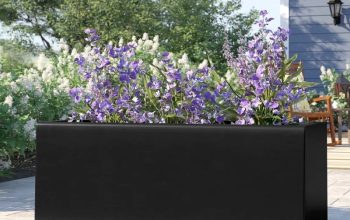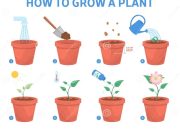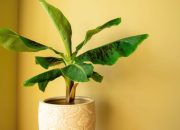Bottle Brush Plant Flower Morphology

Bottle brush plant flowers – Bottle brush plants, belonging to the genusCallistemon*, are renowned for their striking, cylindrical flower spikes that resemble—you guessed it—bottle brushes. Understanding the morphology of these flowers is key to appreciating their unique beauty and evolutionary adaptations. This section delves into the structure of individual flowers, variations across species, and the overall arrangement of flowers within the inflorescence.
The individual flower of a bottle brush plant is relatively small and inconspicuous when viewed in isolation, but the collective effect of numerous flowers densely packed together creates the iconic brush-like appearance. Each flower possesses the typical components of a complete flower, although some features are highly modified compared to other plant species.
Bottle Brush Flower Structure
The bottle brush flower consists of several key parts. Most notably, numerous prominent stamens, which are the male reproductive organs, are responsible for the plant’s showy display. These stamens are long, thin filaments tipped with pollen-bearing anthers. These anthers are often brightly colored, contributing to the overall vibrancy of the flower spike. The petals, in contrast, are small and inconspicuous, often barely noticeable amongst the showy stamens.
The pistil, the female reproductive organ, is positioned centrally within the flower, often extending beyond the stamens. It consists of a stigma (the receptive tip for pollen), a style (a slender stalk), and an ovary (at the base, containing the ovules). The arrangement of these parts is crucial for pollination, usually by birds attracted to the nectar and pollen.
Variability in Flower Structure Across
Callistemon* Species
Callistemon* Species
While the basic structure remains consistent acrossCallistemon* species, variations exist in the color, length, and number of stamens, as well as the shape and size of the petals and pistil. For instance, some species boast crimson red stamens, while others exhibit shades of pink, orange, or even white. The length of the stamens can also vary significantly, influencing the overall shape and density of the flower spike.
Some species have more densely packed flowers than others. These variations contribute to the remarkable diversity within the genus, offering a range of colors and forms to gardeners and nature enthusiasts alike.
Flower Arrangement in the Inflorescence
The individual flowers of the bottle brush plant are arranged in a dense, cylindrical inflorescence, also known as a spike. This arrangement is crucial for attracting pollinators. The densely packed flowers create a visually striking display, effectively advertising the presence of nectar and pollen to potential pollinators, primarily birds in many cases. The cylindrical shape also facilitates efficient pollen transfer, as birds can easily move along the length of the spike, contacting numerous flowers in the process.
This efficient arrangement maximizes the plant’s reproductive success.
Diagram of a Bottle Brush Flower, Bottle brush plant flowers
| Stamen (Many, long, prominent) |
Anther (Pollen-bearing tip of stamen) |
Pistil (Female reproductive organ) |
Petal (Small, inconspicuous) |
| [Image of Stamen – Description: Long, slender filament topped with a pollen-bearing anther. Often brightly colored.] | [Image of Anther – Description: The pollen-bearing part of the stamen, often a distinct color from the filament.] | [Image of Pistil – Description: Central structure with stigma, style, and ovary. Often extends beyond the stamens.] | [Image of Petal – Description: Small, reduced petal, often barely visible amidst the stamens.] |
Bottle Brush Plant Flower Lifecycle: Bottle Brush Plant Flowers

The bottle brush plant, with its vibrant, cylindrical inflorescences, exhibits a fascinating lifecycle. Understanding its flower development, from the initial bud to its eventual senescence, reveals much about its adaptation to its environment. This lifecycle is heavily influenced by environmental cues, primarily temperature and rainfall, which trigger and regulate the various stages of flowering.
Bottle brush plant flowers, known for their vibrant, cylindrical blooms, are crucial for the plant’s reproductive success. Understanding their function requires examining the broader role of flowers in plant life, as detailed in this informative article: what does flowers do for the plant. Ultimately, these striking bottle brush flowers facilitate pollination and seed production, ensuring the continuation of the species.
Bottle Brush Flower Development Stages
The development of a bottle brush flower progresses through several distinct stages. It begins as a small, tightly closed bud, protected by overlapping bracts. These bracts gradually separate as the flower develops, revealing the immature stamens. As the flower matures, the stamens elongate and the anthers, containing the pollen, become visible, displaying their characteristic bright red or yellow color, depending on the cultivar.
Pollination occurs primarily through birds, attracted to the nectar and the striking color of the flowers. Following pollination, the flower begins to senesce, the petals wither, and the stamens eventually fall off. The ovary, if fertilized, develops into a small, woody capsule containing numerous tiny seeds. This entire process can span several weeks, depending on environmental conditions.
Flowering Timing and Environmental Factors
Bottle brush plants are remarkably sensitive to temperature and rainfall patterns. In regions with distinct wet and dry seasons, flowering is typically triggered by the onset of warmer temperatures and increased rainfall following a dry period. For example, in many parts of Australia, where many bottle brush species are native, flowering often coincides with the spring and summer months, following the winter rains.
Conversely, in areas with milder climates, flowering may be less seasonal and occur throughout the year, although often with peaks during warmer periods. Insufficient rainfall can delay or reduce flowering, while prolonged periods of heat can shorten the flowering period and potentially damage the flowers. The exact timing varies considerably depending on the specific species and the prevailing climatic conditions.
Process of Flower Formation: A Step-by-Step Description
The formation of a bottle brush flower begins with the development of a floral meristem, a group of undifferentiated cells at the tip of a stem. This meristem initiates the development of the floral organs. First, the sepals form, enclosing the developing petals and reproductive structures. Next, the petals develop, followed by the stamens, which are numerous and arranged in a dense, cylindrical cluster.
Finally, the pistil, the female reproductive organ, develops in the center of the flower. The entire process is regulated by a complex interplay of hormones and environmental signals. The sequential development of these floral parts results in the characteristic bottle-brush shape of the inflorescence.
Bottle Brush Flower Lifecycle Timeline
A simplified timeline could be illustrated as follows:| Stage | Description | Duration (Approximate) | Environmental Influence ||—————–|—————————————————|————————-|————————–|| Bud Formation | Small, closed bud develops.
| 1-2 weeks | Warmer temperatures, adequate moisture || Bud Development | Bracts separate, stamens elongate. | 1-2 weeks | Increasing temperatures || Anthesis (Flowering)| Stamens fully developed, pollen released.
| 2-4 weeks | Optimal temperature and moisture || Pollination | Pollen transferred to stigma. | Varies, within flowering period | Pollinators (birds) activity || Senescence | Petals wither, stamens fall.
| 1-2 weeks | Decreasing moisture, temperature changes || Seed Development | (If pollinated) Ovary develops into seed capsule. | Several weeks | Continued moisture |
Bottle Brush Plant Flower Uses and Cultural Significance

Bottle brush plants, with their vibrant, unique flowers, hold more than just aesthetic appeal. They’ve woven themselves into the cultural fabric and practical uses of various societies across the globe, demonstrating a fascinating interplay between nature and human life. Their significance extends beyond simple ornamentation, encompassing traditional medicine, economic benefits, and symbolic representation.
Cultural Significance of Bottle Brush Flowers
The bottle brush plant’s cultural significance varies considerably depending on geographical location and associated traditions. In Australia, where many species are native, the plant often symbolizes resilience and the unique beauty of the Australian landscape. Its bright red flowers, particularly, are often associated with the vibrant colours of the outback. In some indigenous Australian cultures, specific bottle brush species hold spiritual significance, playing a role in ceremonies and storytelling.
Conversely, in other parts of the world, such as parts of South Africa where other bottlebrush species thrive, they might be associated with different symbolic meanings, often tied to local flora and fauna. The symbolic meaning is often tied to the specific species and the local culture’s interpretation of its characteristics.
Bottle Brush Flowers in Traditional Medicine and Other Applications
While not extensively used in mainstream medicine, some bottle brush species have found application in traditional healing practices in various regions. For example, certain parts of the plant have been used in some cultures to treat minor ailments, such as skin irritations or digestive issues. However, it’s crucial to emphasize that the efficacy of these traditional uses requires further scientific investigation.
Beyond medicinal applications, the nectar-rich flowers attract pollinators, contributing to the health of local ecosystems. Additionally, the tough wood of some bottle brush species has been used in crafting small tools or decorative items in certain regions. It is vital to note that any use of bottle brush plants for medicinal purposes should be undertaken with caution and under the guidance of qualified healthcare professionals, as some species may contain compounds that can cause allergic reactions or other adverse effects.
Economic Importance of Bottle Brush Plants
The economic significance of bottle brush plants primarily lies in their widespread use in landscaping and horticulture. Their drought tolerance, vibrant flowers, and relative ease of cultivation make them popular choices for gardens, parks, and other green spaces worldwide. The nursery trade and related industries benefit from the consistent demand for these plants, creating employment opportunities and contributing to local economies.
Furthermore, the plants’ role in attracting pollinators can indirectly benefit agricultural sectors dependent on pollination services. The economic impact can vary depending on the region, with areas that have a strong horticultural industry seeing more significant benefits.
Diverse Uses of Bottle Brush Flowers and Associated Cultures
| Region | Use | Cultural Significance |
|---|---|---|
| Australia | Landscaping, symbolic representation | Resilience, beauty of the Australian landscape, spiritual significance in some indigenous cultures |
| South Africa | Landscaping, potential traditional medicinal uses (requires further research) | Specific cultural meanings tied to local flora and fauna; varies by specific species and local culture. |
| Other regions (e.g., parts of Asia, Americas) | Primarily landscaping, ornamental use | Aesthetic value, often integrated into local gardening traditions. Specific cultural meanings vary greatly. |
Essential Questionnaire
Are bottle brush plants poisonous to humans or pets?
While generally not considered highly toxic, ingestion of bottle brush plant parts can cause mild gastrointestinal upset in some individuals and pets. It’s best to keep them out of reach of children and animals.
How often should I water my bottle brush plant?
Water regularly, especially during dry periods, ensuring the soil remains consistently moist but not waterlogged. Reduce watering frequency during winter months.
How do I propagate bottle brush plants?
Bottle brush plants can be propagated from cuttings or seeds. Cuttings are generally more successful and should be taken from semi-hardwood stems.
What kind of soil do bottle brush plants prefer?
Well-draining soil is crucial. A sandy loam or a mix of garden soil and sand works well. Amend heavy clay soils with organic matter to improve drainage.












